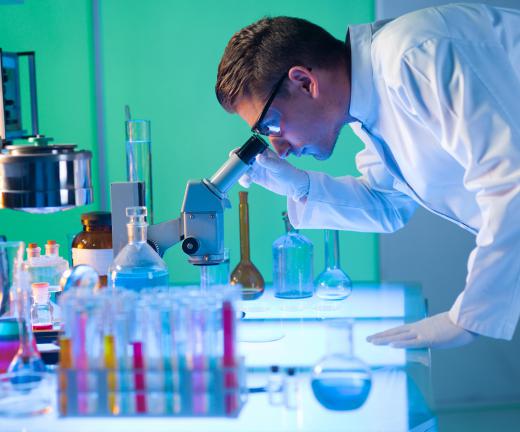What is a Synthetic Peptide?
Peptides are organic molecules in which multiple amino acids are linked by peptide bonds. Each amino acid has a different side chain. All amino acids are comprised of an amino group, which is NH2, and a carboxylate group, which is COOH. When these groups react, they create a peptide bond. When carried out chemically outside of the cell, the peptide is known as a synthetic peptide.
A dipeptide contains two amino acids and has one peptide bond, while a tripeptide has three amino acids and two peptide bonds. The convention is that amino acid chains up to 50 amino acids are known as peptides, while those longer are known as proteins. The major difference in making a synthetic peptide is that the amino acids are added from the carboxylate groups forward. In cells, the ribosomes start synthesizing peptides with the amino group.

The most common method of making synthetic peptides is to use solid-phase peptide synthesis. This allows the formation of a synthetic peptide that would not occur in nature, such as those containing unnatural amino acids. With this method, peptide chains are immobilized on porous beads. The amino acids are treated with the protecting groups Fmoc or Boc to protect them from unwanted reactions.
The peptides undergo repeated cycles of coupling and deprotection. When unprotected, the peptide attached to the solid phase has a free amino-terminal group that is coupled to a nitrogen-protected amino acid unit. Then this unit is deprotected and can further react to attach another amino acid. Once the peptide is complete, it is cleaved from the resin and purified by reverse-phase HPLC. The process making a synthetic peptide can be contracted out to a number of companies.
Peptide synthesis is carried out for a variety of research objectives. Some researchers wish to verify that they have correctly determined the structure of naturally occurring peptides. Others carry out structure/function studies on biologically active proteins and peptides. Such peptides include hormones and a number of toxins. Often synthetic peptides are used as probes to study the active parts of protein molecules.
Peptides are instrumental in mass spectrometry in helping to identify whether a researcher has isolated a particular protein. Each protein breaks down into a pattern of unique peptides that can be detected by mass spectrometry. The process of making antibodies to proteins in animals has become much easier with the advent of peptide synthesis. One does not have to laboriously purify the protein and use it to generate antibodies. One can synthesize a peptide to a fragment of the protein and then use that peptide as the source of the antibodies.
A particularly active area of research on synthetic peptides involves developing new therapeutic techniques, such as novel vaccines. Peptide synthesis is used to generate libraries of peptides to screen for their biological properties. Cell-penetrating peptides have been developed that can introduce various factors into cells, including peptides, proteins, and the building blocks of DNA. Such techniques have great potential as drug delivery systems.
AS FEATURED ON:
AS FEATURED ON:











Discuss this Article
Post your comments